
Proving Historicity of Krishna-Scriptural, historical and archaeological evidences
In the previous articles, we saw different names of lord Krishna and birth related evidences of lord Krishna. In the next article, we shall dig up many ancient scriptures including Jain and Buddhist literature to derive out the most probable time span of lord Krishna.
In previous article, we saw evidences of lord Krishna from various references revolving around Mahabharata and bhagavad gita. Since Mahabharata was a very long story and involved lot of characters, it was not written at once, instead it was compiled completely later over the span of few years. First section of Mahabharata asserts that sage Ved Vyas narrated the events of Mahabharata to lord Ganesha over a considerable time period. Unfortunately, this makes it difficult to predict an exact date of Mahabharata and the time span of Krishna.
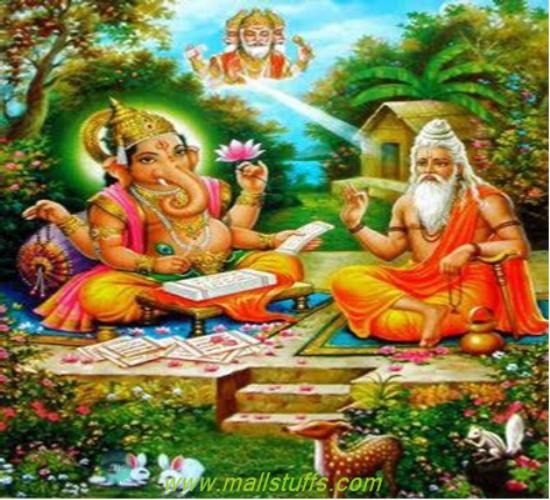
Lord ganesha writing Mahabharata while sage ved vyasa narrates
however some Indian archeologist with the help of some foreign historians discovered Saraswati River and tried to analyze the dry river-bed of Saraswati River.
Saraswati is described as a vanishingriver in Mahabharat, but there is also a citation of Lord Balrama (Krishna brother) navigating on Saraswati River to Mathura from Dwarka , to immerse the ashes of martyrs post the battle between the yadavas clan.
So, from Mahabharata we can imply that the river was navigable and so the Epic must have been written before it had dried up, which as validated by French scientists, was at least before 3000 BCE
Literary work mentioned in Harivamsha give us some more details of Krishna's life that were missing in Mahabharata. Also,Bhagvat-Puran and Vishnu-puran helps to find out more about the personality of Krishna with the former declaring Him as SWAYAM BHAGWAN-the Supreme Personality of Godhead.
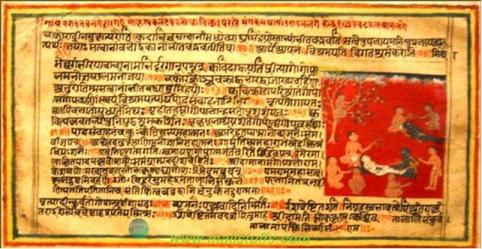
Bhagvatam Manuscript from 1500 CE
In ancient India, no date system was followed and no importance was given to dates. Knowledge was transferred by the Gurus(Teacher) to the Shishya(Student) orally; thus making it more difficult to logically derive the authentic date of these texts in a precise manner. However based on the astronomical details and historical references mentioned in the texts, some dates have been arrived at but the historians are still not sure of those dates.
Literary Conclusive Evidence for Krishna
Not only there are references to Krishna in almost all major ancient scriptures, but also references of many other renowned personalities of that eon in Vedic, Buddhist and Jain scriptures.
Earliest authentic reference to lord Krishna is from Chandogya Upanishad (3.17.6) which was composed around 900 BCE. It mentions Krishna as the son of Devaki and Vasudev and the disciple of Ghora Angirasa.

Guru teaching Krishna and Balarama
Jain scriptures written around 700 BCE, mentions that Vasudev and his elder brother Baladev take birth in each time cycle to free the world from evil and kill the Prati-vasudev or Anti-Krishna. Their scriptures further mentions that Krishna and Balarama born in dwapar yuga were ninth of the Baladeva- Vasudeva series and Krishna is believed to become the 12th Tirthankar of Jain in next cycle time. Additionally, Krishna is also declared as the cousin of Neminath, the 22nd Tirthankar, whose authenticity is believed by most Jains today.
Lord Mahavir, the 24th Tirthankar, was born in 599 BCE, and since consequent Tirthankars are born between a considerable period gap (ranging from decaded to centuries); we can rightly assume Neminath and his cousin Lord Krishna would have been born much before thereby validating the dates of lord Krishna birth between 3300 BC-3200 BC.
This also shows that Krishna was famous not only in Vedic literature but also in Non-Vedic literature as well.
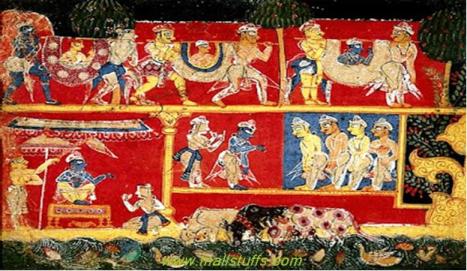
Krishna, cousin of Neminath from a Jain painting
One of the revered sanskrit dictionaries, Yâska's Nirukta, written around 600 BCE, contains a citation to the Syamantaka jewel, taken from the popular puranic tale about Krishna.
Pâ?ini, the well known author of Asthadhyayi of 6th century BCE and also a grammarian testifies Pandavs, Vâsudev and Kauravs contemporaries of each other.
Since palini was a linguist nonchalant of religion, his references are significant especially as they have no sectarian intent. In Sutra 4.3.98, He deduces a word called Vasudevarjunabhyam vun which means Vasudev Krishna and Arjun together.
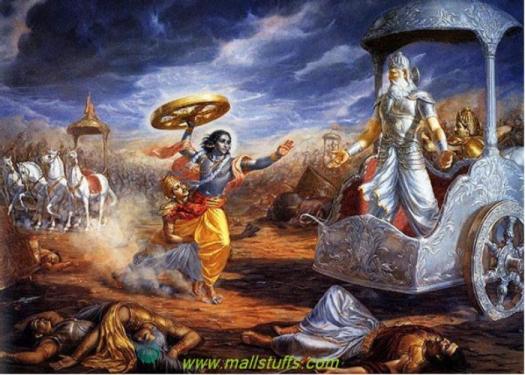
Historical characters from Mahabharat
In addition to Jain scriptures, Buddhist literatures also have many references to historical characters of Mahabharata including lord Krishna.
Buddhist literature Ghata-Jataka written around 300 BCE records mentions Krishna as an ancient king of India and gives many example of lord Krishna exploits against his enemies similar to what we find in our scriptures. Some of the examples are presence of Baladev and Vasudev, killing of demon Kamsa, slaying their cousins, helping pandavas in defeating kauravas.
Another Buddhist literature, Mahaummagga Jataka, written around 3rd century BCE, has a statement on Jambavati as one of the consorts of Vasudeva krishna which conform to Indian scriptures.
Around 150 BCE, Buddhist author Patanjali praises Krishna and Balrama (Samkarshan) in his book Mahabhashya. He also describes amazing wrestling and magical performances by Vasudev (Krishna-Kamsopacharam) before killing of Kamsa

Krishna liberates Kamsa
Surprisingly, even the foreign scholars such as those who arrived India during Alexander's campaign have provided plenty of evidence.
Megasthenes (350BCE), the first western (Greek) Ambassador to Chandragupta Maurya, compares Krishna with the Greek Hercules or Heracles in his famous work Indica.
According to his comparision, there was an Indian tribe called Sourasenoi, residing in two cities Methora and Kleisobora having a navigable river Jobares situated nearby, worshipping Herakles in their land.
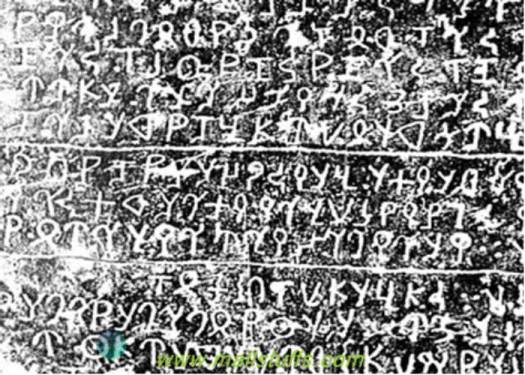
Inscription from the Indica
From the above description, we can easily refer what Megasthenes wanted to say
Herakles refer to Krishna,
Sourasenoi denote Krishna's clan, the Shurasena Yadavas;
Methora refers to Mathura, birth place of krishna;
Jobares refers to Yamuna, the river situated at the banks to Mathura.
Kleisobora refers to Krishnapura, kingdom if lord Krishna.
Beside these, there were many other similarities in the deeds performed by Herakles and Krishna
For example, Krishna defeated the gigantic serpent Kaliya whose very presence could kill anyone with its terrible poison; whereas Herakles kills the equally massive Hydra and also beheaded the Medusa, the snake-headed witch whose single stare could change anyone into stone.
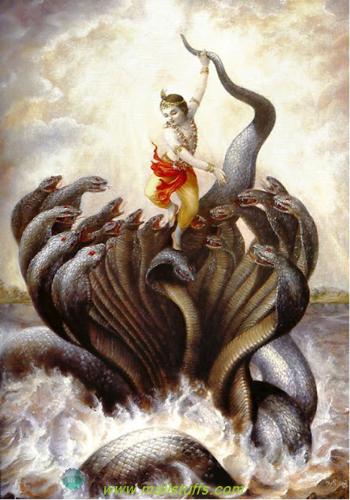
Krishna subduing the monstrous serpent Kaliya
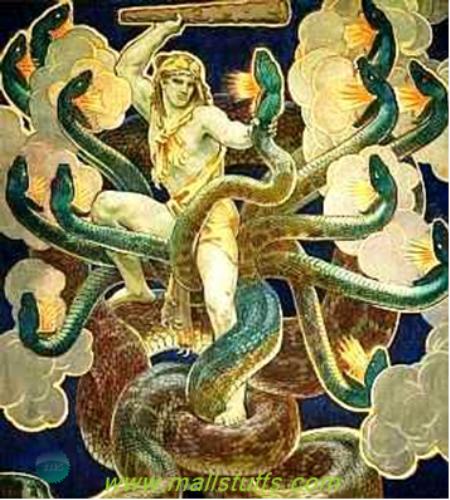
Hercules defeating the serpentine Hydra
By such comparision, the greek historians may be attempting to make sense of their own gods by equating them with other religion god’s
Greek writer, Quintus Curtius, alluded that when Porus/Puru were confronted by Alexander on the banks of the Indus River, foremost Porus's soldiers were carrying an image of Herakles as their banner or mentor. Quintus Curtius was actually referring to lord Krishna but used herakles as he was not aware of lord Krishna.
Maurya dynasty scholar states that the city Polibrotha (Present day Patna or ancient Pataliputra) was established by Herakles(Krishna), 138 generations before the dominion of ruler Sandrocottas, the Greek adaptive name for King Asoka grandfather-Chandragupta Maurya.
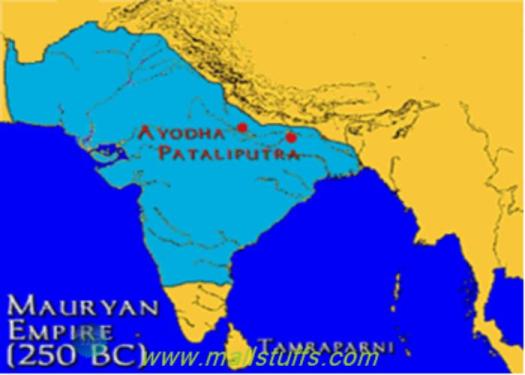
Chandragupta Maurya Empire
From the above text, we can again derive the lord Krishna reign to be around 3300-3200 B.C
Here, the scholar may have assumed the governing span of each ruler to be around 15-25 years depending on life expectancy, success in battle and family-feuds. Calculating 20 years for 138 generations give us the date of 3100 years between Chandragupta Maurya and Hercules thus giving the ruling time of lord Krishna close to 3300 BCE.
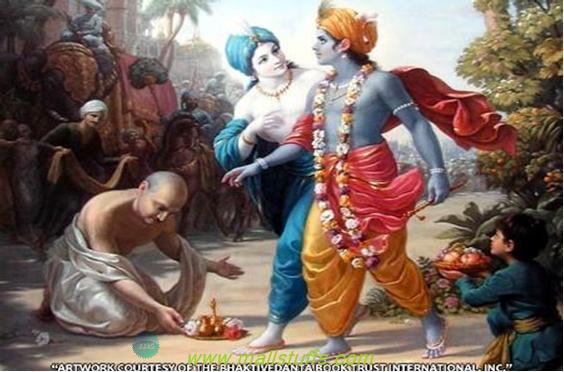
Lord Krishna, most powerful king ruled atleast 3000 years before Chandragupta Maurya
Having mentioned some of the historical records, let us now see the Archaeological evidence in favor of lord Krishna.
Indus-Saraswati Evidence for Krishna
Many seals, scultures and artifacts of the Indus-Saraswati civilization showcase an enchanting picture of the personalities or events stated in the Vedic literature.
Numerous seals of the Indus saraswati period have been identified with the Mother Goddess, Holy Bull, Yogi Shiva, Rishabh-dev; undefeated Emperor Bharat etc. thus verifying the Vedic scriptures.
A soapstone tablet, excavated from Mohenjodaro in 1931, shows two human figures emerging from two trees, uprooted by an adolescent boy. This tablet has been considered as a compelling archaeological evidence for deriving the timespan of lord Krishna.

Dr. E.J.H. Mackay, who executed the digging at Mohanjodaro site, equates this image with the Yamalarjuna episode of lord krishna which was then validated by Prof. V.S. Agrawal.
If you are not aware of the Yamalarjuna episode then below is the small description:
Once two gandharvas Nalkubera & Manigriva were playing nude with celestial maidens in river ganga. When sage Narada came that way after paying a visit to Lord Vishnu, all maidens covered themselves but Manigriva and Nalakuvara were too intoxicated to realize sage Narada and hence remained nude and started joking on narada. Narada cursed them to become trees as a punishment of their excessive materialistic indulgences and declared that only Lord Vishnu avatar (Krishna) after many years would liberate them from the curse.
So in the image excavated from mohen jo daro, the young boy is lord krishna and two emerging creatures are the two cursed Gandharvs Manigriva & Nalkubera

The Yamalarjuna episode
This shows that the Indus-Saraswati citizens acknowledge lord Krishna�s exploited deeds and actions.
The seals excavated from Indus-Valley show an abundance of animal species ranging from Horses to Fish and Unicorns to Bulls giving a glance of lord Vishnu, lord Shiva and its subordinate species. Among trees, there is one particular type of tree and its leaves depicted in seals excavated in all Indus valley sites - the Peepal leaves.
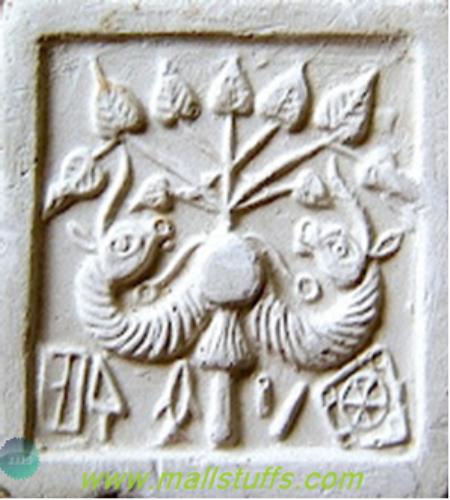
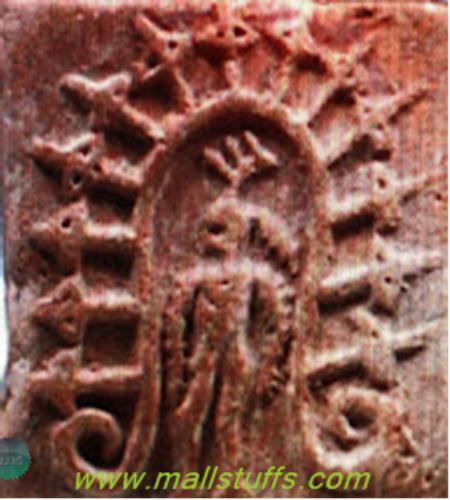
Peepal Leaves on Indus-Saraswati seals
In the 10th chapter of Bhagawad-Gita, Krishna says that he represents the Pipal or Aswatha amongst the trees. Now the leaves depicted on any Indus Seal refers to the Pipal leaf- the illustration of Krishna in non-anthropomorphic form. This is also the reason why pipal trees are considered sacred in India.
As per the srimad bhagavatam, lord Krishna appeared to sage Markandeya as a baby on a pipal leaf when the world was dissolving in the cosmic waters.
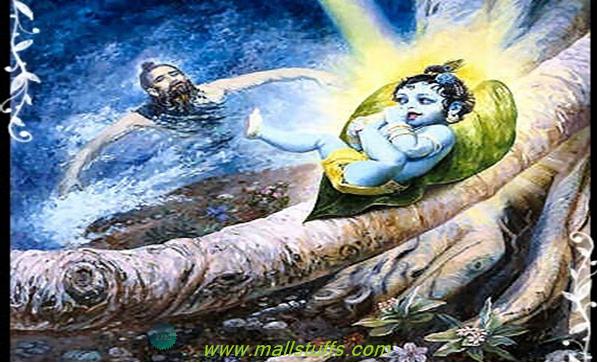
Lord Krishna on Pipal leaf
Evidence from Marine Archaeology
Recently, There have been an discovery of an entire civilization submerged in gulf of
cambay near the coast of dwaraka.On carbon dating, this civilization has been predicted as atleast 7500 years old.! {Check this link for more details -Lost city of dwaraka}
You can also check the below YouTube link for details on the discovery of city dwarka near the coast of gujarat
Gulf of Cambay
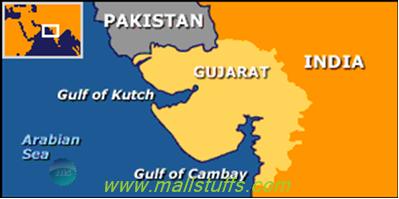
The possiblity of this civilization being OLDER than the Indus-Saraswati Civilization is immense and can be linked
with the legendary kingdoms of yore as mentioned in Hindu texts There have been an discovery of one more city submerged close to the present city of Dwarka. Because of the abundant archaeological evidences like seals, scultures, architectural designs matching with the ancient hindu scriptures, this city is considered to be constructed by vishwakarma under the order of lord Krishna !!
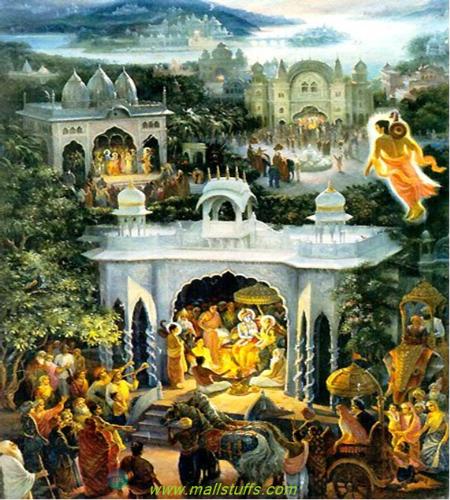
Dwaraka, the Magnificent City of Krishna
We shall see the details of this discovery and other proof of lord Krishna in my next article.
Before ending, wishing all of you a very happy janmashtami with the following wonderful message from bhagavad gita
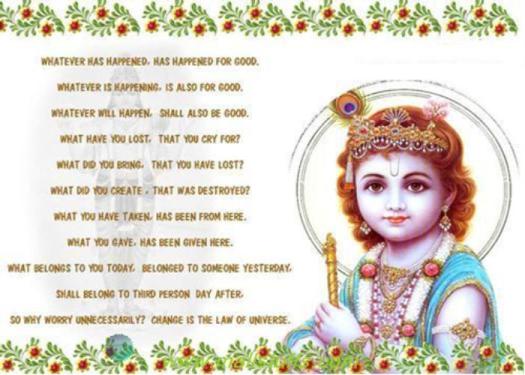
Note: Images used on this website
are either a production of Bhaktivedanta Book Trust(https://www.krishna.com), Iskcon
Foundation or were found in google search under "Free to use and share". If any
of the images presented here violates copyright issues or infringes anyone copyright
or are not under "Fair use", then please bring it to our notice. Read
Disclaimer for more.
Share this to your friends. One of your friend is
waiting for your share.
Related Articles
Hinduism greatness quotes by famous philosophers and scientists
Bhagavad gita quote against caste system
Science in Hinduism-Large numbers and infinity
Science in hinduism-Test tube babies
Is god female-Yes or No
Does kung fu has its origin in india
Do plants sing or create music
Aum-The sacred word of all religions
Is Goddess Durga the supreme universal mother
Why lord Ganesha have elephant head
Post Comment